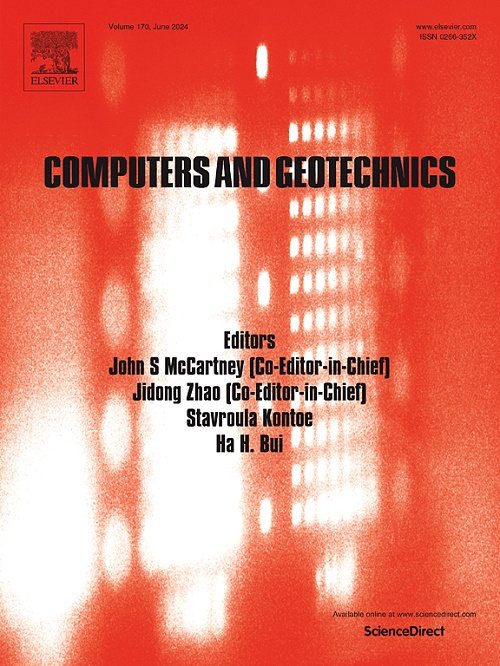A hybrid resolved CFD-DEM study on internal erosion in gap-graded soils considering coarse particle shape
IF 5.3
1区 工程技术
Q1 COMPUTER SCIENCE, INTERDISCIPLINARY APPLICATIONS
引用次数: 0
Abstract
This study proposed a novel hybrid resolved framework coupling computational fluid dynamics (CFD) with discrete element method (DEM) to investigate internal erosion in gap-graded soils. In this framework, a fictitious domain (FD) method for clump was developed to solve the fluid flow around realistic-shaped coarse particles, while a semi-resolved method based on a Gaussian-weighted function was adopted to describe the interactions between fine particles and fluid. Firstly, the accuracy of the proposed CFD-DEM was rigorously validated through simulations of flow past a fixed sphere and single ellipsoid particle settling, compared with experimental results. Subsequently, the samples of gap-graded soil considering realistic shape of coarse particles were established, using spherical harmonic (SH) analysis and clump method. Finally, the hybrid resolved CFD-DEM model was applied to simulate internal erosion in gap-graded soils. Detailed numerical analyses concentrated on macro–micro mechanics during internal erosion, including the critical hydraulic gradient, structure deformation, as well as particle migration, pore flow, and fabric evolution. The findings from this study provide novel insights into the multi-scale mechanisms underlying the internal erosion in gap-graded soils.
考虑粗粒形状的间隙级配土内部侵蚀的混合分辨CFD-DEM研究
本文提出了一种将计算流体力学(CFD)与离散元法(DEM)相结合的新型混合分解框架,用于研究间隙级配土壤的内部侵蚀。在此框架下,提出了基于团块的虚拟域(FD)方法来求解真实形状的粗颗粒周围的流体流动,采用基于高斯加权函数的半分解方法来描述细颗粒与流体之间的相互作用。首先,通过对固定球体流动和单椭球颗粒沉降的模拟,与实验结果进行比较,严格验证了CFD-DEM的准确性。随后,采用球谐分析和团块法,建立了考虑实际粗颗粒形状的间隙级配土样品。最后,应用CFD-DEM混合分解模型对间隙级配土壤的内侵蚀进行了模拟。详细的数值分析集中于内侵蚀过程中的宏观微观力学,包括临界水力梯度、结构变形、颗粒迁移、孔隙流动和织物演化。本研究的发现为裂隙级配土壤内部侵蚀的多尺度机制提供了新的见解。
本文章由计算机程序翻译,如有差异,请以英文原文为准。
求助全文
约1分钟内获得全文
求助全文
来源期刊

Computers and Geotechnics
地学-地球科学综合
CiteScore
9.10
自引率
15.10%
发文量
438
审稿时长
45 days
期刊介绍:
The use of computers is firmly established in geotechnical engineering and continues to grow rapidly in both engineering practice and academe. The development of advanced numerical techniques and constitutive modeling, in conjunction with rapid developments in computer hardware, enables problems to be tackled that were unthinkable even a few years ago. Computers and Geotechnics provides an up-to-date reference for engineers and researchers engaged in computer aided analysis and research in geotechnical engineering. The journal is intended for an expeditious dissemination of advanced computer applications across a broad range of geotechnical topics. Contributions on advances in numerical algorithms, computer implementation of new constitutive models and probabilistic methods are especially encouraged.
 求助内容:
求助内容: 应助结果提醒方式:
应助结果提醒方式:


